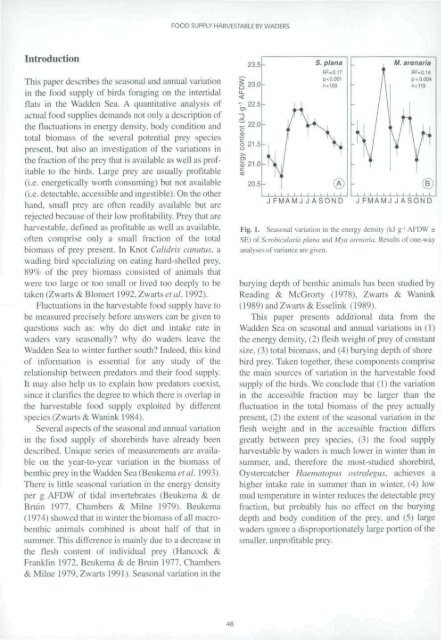waders and their estuarine food supplies - Vlaams Instituut voor de ...
waders and their estuarine food supplies - Vlaams Instituut voor de ...
waders and their estuarine food supplies - Vlaams Instituut voor de ...
Create successful ePaper yourself
Turn your PDF publications into a flip-book with our unique Google optimized e-Paper software.
Introduction<br />
This paper <strong>de</strong>scribes the seasonal <strong>and</strong> annual variation<br />
m ihe <strong>food</strong> supply of birds foraging on the intertidal<br />
tlais in the Wad<strong>de</strong>n Sea. A quantitative analysis of<br />
actual <strong>food</strong> <strong>supplies</strong> <strong>de</strong>m<strong>and</strong>s not only a <strong>de</strong>scription of<br />
the fluctuations in energy <strong>de</strong>nsity, body condition <strong>and</strong><br />
total biomass of the several potential prey species<br />
present, but also an investigation of the variations in<br />
the fraction of the pre\ that is available as well as profitable<br />
to the birds. Large prey are usually profitable<br />
(i.e. energetically worth consuming) but not available<br />
(i.e. <strong>de</strong>tectable, accessible <strong>and</strong> ingestible). On the other<br />
h<strong>and</strong>, small prey are often readily available but are<br />
[ejected because of <strong>their</strong> low profitability. Prey that arc<br />
harvestable. <strong>de</strong>fined as profitable as well as available.<br />
Often comprise only a small fraction of the total<br />
biomass of ptev present. In Knot Calidris caniiiiis. a<br />
wading bird specializing on eating hard-shelled prey.<br />
89% of the prey biomass consisted of animals that<br />
were too large or loo small or lived too <strong>de</strong>eply lo be<br />
taken (Zwarts & Blomert 1992, Zwarts etal. 1992).<br />
Fluctuations in the harvestable fcxxl supply have in<br />
be measured precisely before answers can be given to<br />
questions such as: why do diet <strong>and</strong> intake rate in<br />
<strong>wa<strong>de</strong>rs</strong> vary seasonally? why do <strong>wa<strong>de</strong>rs</strong> leave the<br />
Wad<strong>de</strong>n Sea to winter further south? In<strong>de</strong>ed, this kind<br />
of information is essential for any study of the<br />
relationship between predators <strong>and</strong> <strong>their</strong> lood supply.<br />
Il may also help us to explain how predators coexist.<br />
since it clarifies the <strong>de</strong>gree to which there is overlap in<br />
the harvestable fcxxl supply exploited by different<br />
species (Zwarts & Wanink 1984).<br />
Several aspects of the seasonal <strong>and</strong> annual variation<br />
in the fcxxl supply of shorebirds have already been<br />
<strong>de</strong>scribed. Unique series of measurements are available<br />
on the year-to-year variation in the biomass of<br />
benthic prey in the Wad<strong>de</strong>n Sea (Beukema et al. 1993).<br />
There is little seasonal variation in the energy <strong>de</strong>nsit)<br />
per g AFDW of tidal invertebrates (Beukema & <strong>de</strong><br />
Bruin 1977. Chambers & Milne 1979). Beukema<br />
(1974) showed that in winter the biomass of all macrobenlhic<br />
animals combined is about half of that in<br />
summer. This difference is mainly due to a <strong>de</strong>crease in<br />
the flesh content of individual prey (Hancock &<br />
Franklin 1972. Beukema & <strong>de</strong> Bruin 1977. Chambers<br />
& Milne 1979. Zwarts 1991). Seasonal variation in the<br />
FOOD SUPPLY HARVESTABLE BY WADERS<br />
48<br />
JFMAMJJASOND JFMAMJ J A SOND<br />
Ki|i. I. Seasonal varialion in the energv <strong>de</strong>nsit) ik.l g ' AFDW ±<br />
SE) ul Scrobicularia plana <strong>and</strong> Mya iircnuriti. Results nf one-way<br />
analyses ol variance are given.<br />
burying <strong>de</strong>pth of benthic animals has been studied by<br />
Reading & McGrorty (1978). Zwarts & Wanink<br />
(1989) <strong>and</strong> Zwarts & Esselink (1989).<br />
This paper presents additional data from the<br />
Wad<strong>de</strong>n Sea on seasonal <strong>and</strong> annual variations in (I)<br />
the energy <strong>de</strong>nsity. (2) llesh weight of prey of constant<br />
si/e. (3) total biomass. <strong>and</strong> (4) burying <strong>de</strong>pth of shorebird<br />
prey. Taken together, these components comprise<br />
the main sources ol variation in the harvestable <strong>food</strong><br />
supply of the birds. We conclu<strong>de</strong> that (1) the variation<br />
in the accessible fraction may be larger than the<br />
fluctuation in the total biomass of the prey actually<br />
present, (2) the extent of the seasonal variation in the<br />
flesh weight <strong>and</strong> in the accessible fraction differs<br />
greatly between prey species. (3) the <strong>food</strong> supply<br />
harvestable by <strong>wa<strong>de</strong>rs</strong> is much lower in winter than in<br />
summer, <strong>and</strong>, therefore the most-studied shorebird.<br />
Oystercatcher Haematopus ostralegus, achieves a<br />
higher intake rate in summer than in winter. (4) low<br />
mud temperature in winter reduces the <strong>de</strong>tectable prey<br />
fraction, but probably has no effect on the burying<br />
<strong>de</strong>pth <strong>and</strong> body condition of the prey, <strong>and</strong> (5) large<br />
<strong>wa<strong>de</strong>rs</strong> ignore a disproportionately large portion of the<br />
smaller, unprofitable prey.

















